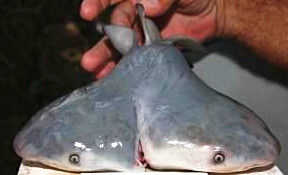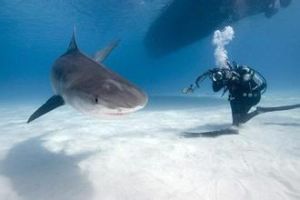Introduction
the bull shark (Carcharhinus leucas,) takes its name from its stocky body type, broad flat nose and aggressive behavior cannot be predicted at the bull shark (Carcharhinus leucas,) takes its name from its stocky body type, broad flat nose and aggressive behavior cannot be predicted at . in India, the bull shark is commonly referred to as the Sundarbans or Ganges shark;In Africa and Nicaragua respectively referred to as the Zambezi shark, Nicaragua shark and the bull shark in India, the bull shark is commonly referred to as the Sundarbans or Ganges shark;In Africa and Nicaragua respectively referred to as the Zambezi shark, Nicaragua shark and the bull shark .
is a kind of warm and shallow water with common shark, unlike other sea shark, the bull shark can tolerate fresh water in rivers can haunt them is a kind of warm and shallow water with common shark, unlike other sea shark, the bull shark can tolerate fresh water in rivers can haunt them . .
So, they are almost always caused by the near - shore attacks in certain kinds of material, including many species that is considered to be a cause of So, they are almost always caused by the near - shore attacks in certain kinds of material, including many species that is considered to be a cause of . case, however, the bull shark are not true freshwater sharks case, however, the bull shark are not true freshwater sharks .
Morphological Feature
Carcharhinus leucas bear is big and solid, males up to 2.1 m long and weighs 90 kg, and females are larger, up to 3.5 m long and 230 kg of heavy bull shark than other sharks of relatively wide, the top and bottom, respectively, of the gray and white bull shark than other sharks of relatively wide, the top and bottom, respectively, of the gray and white .
body spindle body, torso coarse body spindle body, torso coarse . head head .
wide flat tail groups above and below an upper end with an wide flat tail groups above and below an upper end with an . kiss very wide circular eyes and short round kiss very wide circular eyes and short round .
, , . developed nictitating membrane anterior nasal flaps carried a broad triangle;Non - oral - nasal barbel schizothoracin developed nictitating membrane anterior nasal flaps carried a broad triangle;Non - oral - nasal barbel schizothoracin .
groove or arcuate, mouth closed when the edge of the upper and lower tensioning, seldom bite;maxillary tooth side is flat and wide, margin crenate - serrulate, the tips of the teeth of the outer upright or slightly inclined, no sharp denticles;mandibular teeth with a narrow upright or slightly oblique jaw, margin serrate, base is nearly smooth dorsal blowhole absent groove or arcuate, mouth closed when the edge of the upper and lower tensioning, seldom bite;maxillary tooth side is flat and wide, margin crenate - serrulate, the tips of the teeth of the outer upright or slightly inclined, no sharp denticles;mandibular teeth with a narrow upright or slightly oblique jaw, margin serrate, base is nearly smooth dorsal blowhole absent . .
2, without the ridge between the dorsal fin, first dorsal fin is large, the starting point and behind the pectoral fin bases, the trailing edge is recessed at the lower corner of the hypostyle court;The second dorsal fin is small, a point that is prior to or with respect to the fin, the posterior concave, the apex of the angle after the projection;large pectoral fins, are falcate, the trailing edge of the recess, the outer blunt tip, a rounded corner, the fin end of which extends up to the rear end of the first dorsal fin base;caudal fin is long and broad caudal axis, the triangular protrusion significantly lower lobe anterior, middle, low and flat, and has a deep notch between the rear, the rear small triangular projecting tail 2, without the ridge between the dorsal fin, first dorsal fin is large, the starting point and behind the pectoral fin bases, the trailing edge is recessed at the lower corner of the hypostyle court;The second dorsal fin is small, a point that is prior to or with respect to the fin, the posterior concave, the apex of the angle after the projection;large pectoral fins, are falcate, the trailing edge of the recess, the outer blunt tip, a rounded corner, the fin end of which extends up to the rear end of the first dorsal fin base;caudal fin is long and broad caudal axis, the triangular protrusion significantly lower lobe anterior, middle, low and flat, and has a deep notch between the rear, the rear small triangular projecting tail . dark grey dorsal side, ventral side grey;Each fin tip dark dark grey dorsal side, ventral side grey;Each fin tip dark .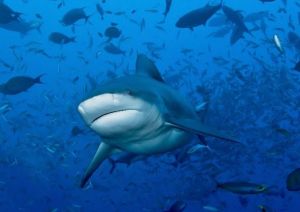
Distribution Range
Carcharhinus leucas distribution in western Australia and Brazil to any of the tropical and subtropical waters of the Atlantic coastal Carcharhinus leucas distribution in western Australia and Brazil to any of the tropical and subtropical waters of the Atlantic coastal . in the east and west, the Pacific Ocean in the east and west, the Indian Ocean in the West Bank, is in the range of latitude of 40 degrees, in the South China sea, there is also in the east and west, the Pacific Ocean in the east and west, the Indian Ocean in the West Bank, is in the range of latitude of 40 degrees, in the South China sea, there is also .
Living Habits
Habitat Carcharhinus leucas can tolerate fresh water, they warm the ocean coast, the reef area, sand or mud, the estuaries of rivers and lakes, and freshwater or saltwater are common in both Habitat Carcharhinus leucas can tolerate fresh water, they warm the ocean coast, the reef area, sand or mud, the estuaries of rivers and lakes, and freshwater or saltwater are common in both . bull shark can reach a depth of 150 m, but usually not deeper than 300 m bull shark can reach a depth of 150 m, but usually not deeper than 300 m .
low oceanic whitetip shark Carcharhinus longimanus L of the tail near the special visceral energy storage salt, specialized kidneys can cycle in which the body is used which is salty, making it almost life - living in fresh water low oceanic whitetip shark Carcharhinus longimanus L of the tail near the special visceral energy storage salt, specialized kidneys can cycle in which the body is used which is salty, making it almost life - living in fresh water . Carcharhinus leucas alone haunted by predators, they are generally shallow wandering Carcharhinus leucas alone haunted by predators, they are generally shallow wandering .
Carcharhinus leucas may appear docile, but may be suddenly hyperactive Carcharhinus leucas may appear docile, but may be suddenly hyperactive . they are highly aggressive,even the attack on the Brisbane River, Queensland, Australia, the horse - race they are highly aggressive,even the attack on the Brisbane River, Queensland, Australia, the horse - race .
they have extremely territorial, and will attack other invading organisms (including humans) they have extremely territorial, and will attack other invading organisms (including humans) . Many experts believe the low oceanic whitetip shark Carcharhinus longimanus is Port Jackson to stage a spate of fatalities of the murderer Many experts believe the low oceanic whitetip shark Carcharhinus longimanus is Port Jackson to stage a spate of fatalities of the murderer .
in India, Carcharhinus leucas Ganga life, kill and hurt a lot of life;They also feed on Indians put her down on the corpses of in India, Carcharhinus leucas Ganga life, kill and hurt a lot of life;They also feed on Indians put her down on the corpses of . Carcharhinus leucas mainly comprising other shark (Carcharodon carcharias) even including fishes, Raja also eat rodents, dolphins, sea turtles, birds, molluscs, echinoderms, crustaceans, and even dog Carcharhinus leucas mainly comprising other shark (Carcharodon carcharias) even including fishes, Raja also eat rodents, dolphins, sea turtles, birds, molluscs, echinoderms, crustaceans, and even dog .
Carcharhinus leucas also often in the estuary of a river upriver to hunt hippopotamus, crocodile - like aquatic Carcharhinus leucas also often in the estuary of a river upriver to hunt hippopotamus, crocodile - like aquatic . Carcharhinus leucas viviparous reproduction, typically in estuarine waters in summer production Carcharhinus leucas viviparous reproduction, typically in estuarine waters in summer production .
pregnancy for a year, the cubs at a time 1 to the tail 13 pregnancy for a year, the cubs at a time 1 to the tail 13 . pups at birth is about 70 cm long,takes about 10 years to reach maturity to pups at birth is about 70 cm long,takes about 10 years to reach maturity to .
whose life is usually 12 years whose life is usually 12 years . Carcharhinus leucas Eater has very strange behavior, the strongest of the embryo in the uterus will eat unfertilized ovum or embryo and therefore weaker Carcharhinus leucas Eater has very strange behavior, the strongest of the embryo in the uterus will eat unfertilized ovum or embryo and therefore weaker .
, their hunting skills in Shaolin.You will begin, finally, only the strongest and most ferocious; only those who have to live with 1 2 1 2.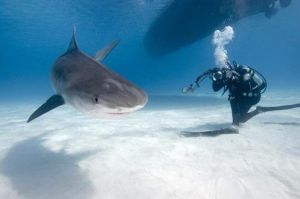
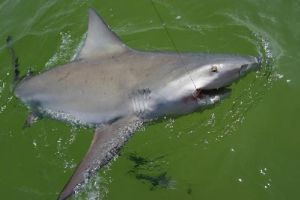
Utilization In Fisheries
mainly to bait - fish, and gillnetting and longline capture high economic value. The meat quality, can be processed into a variety of meat products;shark's fin can do;Thick skin their hides.liver can be made into vitamins and oil;
Esculentae fishmeal Esculentae fishmeal.
Related Research
powerful bite force on 16 October 2012, the University of South Florida researchers pointed out that in all type of shark, the bull shark bite strength is the most powerful, even worse than the great white shark (Carcharodon carcharias) powerful bite force on 16 October 2012, the University of South Florida researchers pointed out that in all type of shark, the bull shark bite strength is the most powerful, even worse than the great white shark (Carcharodon carcharias) . the bull shark, the jaw and jaw muscles so that they can be engaged by generating 1300 lbs of force, ranking with any large predatory sharks of the bull shark, the jaw and jaw muscles so that they can be engaged by generating 1300 lbs of force, ranking with any large predatory sharks of .
3 stud bull shark found in the Gulf of Mexico for the first time Beijing time on March 27, moving from place to place, from Michigan State University scientist in "fish biology in the Journal of Fish Biology, sayThey have confirmed the first discovered in the stud of the bull shark 3 stud bull shark found in the Gulf of Mexico for the first time Beijing time on March 27, moving from place to place, from Michigan State University scientist in "fish biology in the Journal of Fish Biology, sayThey have confirmed the first discovered in the stud of the bull shark . this shark to April 7, 2011 in the Gulf of Mexico found that, as a single individual, rather than conjoined twins shark this shark to April 7, 2011 in the Gulf of Mexico found that, as a single individual, rather than conjoined twins shark .
however, found this strange phenomenon, the probability is very low, in part because, with deformed creatures usually at birth and died shortly after the however, found this strange phenomenon, the probability is very low, in part because, with deformed creatures usually at birth and died shortly after the . in this example, the fishermen were taken in an adult shark of uterus was discovered after bar stud bull shark, but it also soon died in this example, the fishermen were taken in an adult shark of uterus was discovered after bar stud bull shark, but it also soon died .
under field conditions, this dual head of sharks there is substantially no chance of survival under field conditions, this dual head of sharks there is substantially no chance of survival .